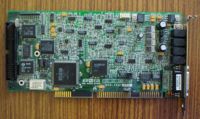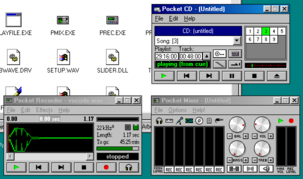
Media Vision Pro AudioSpectrum
Encyclopedia

Media Vision
Media Vision was an American electronics manufacturer of primarily computer sound cards and CD-ROM kits, operating from 1990 to approximately 1995 in Fremont, California...
Pro AudioSpectrum (commonly referred to as "PAS") family of personal computer sound cards included the original 8-bit Pro AudioSpectrum (1991), the 8-bit Pro AudioSpectrum Plus, 16-bit Pro AudioSpectrum 16, Pro AudioSpectrum 16 Basic and 16-bit Pro Audio Studio. All PAS cards with the exception of Pro AudioSpectrum 16 Basic could connect to CD-ROM drives—variants having SCSI
SCSI
Small Computer System Interface is a set of standards for physically connecting and transferring data between computers and peripheral devices. The SCSI standards define commands, protocols, and electrical and optical interfaces. SCSI is most commonly used for hard disks and tape drives, but it...
or various proprietary interfaces—and many were sold in multimedia kits with compatible CD-ROM drives.
Though the 8-bit Pro AudioSpectrum cards were only modestly successful, the 16 bit-series cards aimed toward semi-professional users and hobby musicians were quite popular. These gave serious competition to the SoundBlaster 16. Most games in the mid 1990s had genuine support for the PAS cards, thus the lack of Sound Blaster Pro and Sound Blaster 16
Sound Blaster 16
The Sound Blaster 16 is a series of sound cards by Creative Technology. They are add-on boards for PCs with an ISA or PCI slot.-Sound Blaster 16:Sound Blaster 16 , the successor to the Sound Blaster Pro, introduced 16-bit digital audio sampling to the Sound Blaster line...
compatibility was not much of a problem.
Media Vision was the original equipment manufacturer
Original Equipment Manufacturer
An original equipment manufacturer, or OEM, manufactures products or components that are purchased by a company and retailed under that purchasing company's brand name. OEM refers to the company that originally manufactured the product. When referring to automotive parts, OEM designates a...
(OEM) of the Logitech SoundMan (also marketed as Pro AudioSpectrum 16 Basic) card, which was compatible with the PAS and could thus use the same drivers.
The relevance of the PAS faded quickly as Media Vision was rocked by financial scandal and faded from existence.
Digital and FM audio
The 16-bit PAS cards employed a relabeled CODECCodec
A codec is a device or computer program capable of encoding or decoding a digital data stream or signal. The word codec is a portmanteau of "compressor-decompressor" or, more commonly, "coder-decoder"...
chip made by Crystal Semiconductors of Austin, Texas
Austin, Texas
Austin is the capital city of the U.S. state of :Texas and the seat of Travis County. Located in Central Texas on the eastern edge of the American Southwest, it is the fourth-largest city in Texas and the 14th most populous city in the United States. It was the third-fastest-growing large city in...
(now part of Cirrus Logic
Cirrus Logic
Cirrus Logic is a fabless semiconductor supplier specializing in analog, mixed-signal, and audio DSP integrated circuits . They are presently headquartered in Austin, Texas. Their audio processors and audio converters are found in many professional audio and consumer entertainment products,...
) for digital audio playback and recording and an AdLib
AdLib
Ad Lib, Inc. was a manufacturer of sound cards and other computer equipment founded by Martin Prevel, a former professor of music and vice-dean of the music department at the Université Laval...
-compatible Yamaha
Yamaha
Yamaha may refer to:* Yamaha Corporation, a Japanese company with a wide range of products and services** Yamaha Motor Company, a Japanese motorized vehicle-producing company...
OPL3 FM music synthesizer. The 8-bit versions used different DAC
Digital-to-analog converter
In electronics, a digital-to-analog converter is a device that converts a digital code to an analog signal . An analog-to-digital converter performs the reverse operation...
and ADC
Analog-to-digital converter
An analog-to-digital converter is a device that converts a continuous quantity to a discrete time digital representation. An ADC may also provide an isolated measurement...
parts for playback and recording and used dual AdLib
AdLib
Ad Lib, Inc. was a manufacturer of sound cards and other computer equipment founded by Martin Prevel, a former professor of music and vice-dean of the music department at the Université Laval...
-compatible Yamaha
Yamaha
Yamaha may refer to:* Yamaha Corporation, a Japanese company with a wide range of products and services** Yamaha Motor Company, a Japanese motorized vehicle-producing company...
OPL2 FM music synthesizers to create stereo sound.
Sound Blaster compatibility
To provide true compatibility with the Sound Blaster's 8-bit playback on its 8-bit Pro AudioSpectrum Plus and 16-bit Pro AudioSpectrum 16, Media Vision included the same sound processor chip it used on its Thunder BoardThunder Board
The Thunderboard was an 8-bit mono sound card from Media Vision that had Sound Blaster compatibility at a reduced price. It was widely advertised as “proudly made in the USA”; possibly a reference to the Sound Blaster, manufactured by the competing Singapore-based Creative Technologies...
card. Thus, there were actually two digital audio playback devices on these cards that could also be used at the same time. The analog output of each of the two digital audio channels was combined in the on-board analog mixer.
CD-ROM interface
All Pro AudioSpectrum cards included a CD-ROM interface.Most PAS cards were equipped with a NCR
NCR Corporation
NCR Corporation is an American technology company specializing in kiosk products for the retail, financial, travel, healthcare, food service, entertainment, gaming and public sector industries. Its main products are self-service kiosks, point-of-sale terminals, automated teller machines, check...
-designed 5380 SCSI
SCSI
Small Computer System Interface is a set of standards for physically connecting and transferring data between computers and peripheral devices. The SCSI standards define commands, protocols, and electrical and optical interfaces. SCSI is most commonly used for hard disks and tape drives, but it...
controller made by Zilog
Zilog
Zilog, Inc., previously known as ZiLOG , is a manufacturer of 8-bit and 24-bit microcontrollers, and is most famous for its Intel 8080-compatible Z80 series.-History:...
that boasted a data transfer rate of 690kB/s using PIO
Programmed input/output
Programmed input/output is a method of transferring data between the CPU and a peripheral such as a network adapter or an ATA storage device....
(DMA
Direct memory access
Direct memory access is a feature of modern computers that allows certain hardware subsystems within the computer to access system memory independently of the central processing unit ....
was not supported); though intended for use with CD-ROM drives, these could interface with other SCSI devices with drivers written by Trantor Systems; Windows 95
Windows 95
Windows 95 is a consumer-oriented graphical user interface-based operating system. It was released on August 24, 1995 by Microsoft, and was a significant progression from the company's previous Windows products...
includes drivers for the PAS SCSI interface and autodetects it as a PAS 16 Trantor SCSI host adaptor.
Other PAS cards included proprietary interfaces to CD-ROM drives they were packaged with. These included drives made by Sony
Sony
, commonly referred to as Sony, is a Japanese multinational conglomerate corporation headquartered in Minato, Tokyo, Japan and the world's fifth largest media conglomerate measured by revenues....
and Matsushita (Panasonic
Panasonic
Panasonic is an international brand name for Japanese electric products manufacturer Panasonic Corporation, which was formerly known as Matsushita Electric Industrial Co., Ltd...
). There was also variant with LMSI controller for LMSI Philips CM205, CM206 CD-ROM drives.
MIDI and game port
Each Pro AudioSpectrum sound card included a MPU401-compatible MIDI and Gameport interface similar to those on Sound BlasterSound Blaster
The Sound Blaster family of sound cards was the de facto standard for consumer audio on the IBM PC compatible system platform, until the widespread transition to Microsoft Windows 95, which standardized the programming interface at application level , and the evolution in PC design led to onboard...
cards.
Other features

Printed circuit board
A printed circuit board, or PCB, is used to mechanically support and electrically connect electronic components using conductive pathways, tracks or signal traces etched from copper sheets laminated onto a non-conductive substrate. It is also referred to as printed wiring board or etched wiring...
, and the PC speaker
PC speaker
A PC speaker is a loudspeaker, built into some IBM PC compatible computers. The first IBM Personal Computer, model 5150, employed a standard 2.25 inch magnetic driven speaker. More recent computers use a piezoelectric speaker instead. The speaker allows software and firmware to provide...
support that was done by listening on the ISA
Industry Standard Architecture
Industry Standard Architecture is a computer bus standard for IBM PC compatible computers introduced with the IBM Personal Computer to support its Intel 8088 microprocessor's 8-bit external data bus and extended to 16 bits for the IBM Personal Computer/AT's Intel 80286 processor...
bus rather than using an external cable like the Sound Blaster cards. With the PAS cards, Media Vision also began to include a popular player for Amiga
Amiga
The Amiga is a family of personal computers that was sold by Commodore in the 1980s and 1990s. The first model was launched in 1985 as a high-end home computer and became popular for its graphical, audio and multi-tasking abilities...
sound module (.MOD) files.
Software drivers
Driver support was available under DOSDOS
DOS, short for "Disk Operating System", is an acronym for several closely related operating systems that dominated the IBM PC compatible market between 1981 and 1995, or until about 2000 if one includes the partially DOS-based Microsoft Windows versions 95, 98, and Millennium Edition.Related...
, Microsoft Windows
Microsoft Windows
Microsoft Windows is a series of operating systems produced by Microsoft.Microsoft introduced an operating environment named Windows on November 20, 1985 as an add-on to MS-DOS in response to the growing interest in graphical user interfaces . Microsoft Windows came to dominate the world's personal...
3.x, Windows NT 3.5 and 4.0, Windows 9x, OS/2
OS/2
OS/2 is a computer operating system, initially created by Microsoft and IBM, then later developed by IBM exclusively. The name stands for "Operating System/2," because it was introduced as part of the same generation change release as IBM's "Personal System/2 " line of second-generation personal...
and Linux
Linux
Linux is a Unix-like computer operating system assembled under the model of free and open source software development and distribution. The defining component of any Linux system is the Linux kernel, an operating system kernel first released October 5, 1991 by Linus Torvalds...
(within Open Sound System
Open Sound System
The Open Sound System is an interface for making and capturing sound in Unix or Unix-like operating systems. It is based on standard Unix devices...
). It was also claimed to work under Windows ME or 2000/XP by using Windows 9x or Windows NT 4 / 2000 RC1 drivers. Under DOS, a terminate and stay resident
Terminate and Stay Resident
Terminate and Stay Resident is a computer system call in DOS computer operating systems that returns control to the system as if the program has quit, but keeps the program in memory...
driver called mvsound.sys had to be used in order to initialize the card although most programs did not use this driver but rather programmed the PAS chip directly.

